Sales edge up, after sagging for months, amid Crazy Spiking Prices.
Inventories of existing single-family houses, condos, and co-ops rose for the fourth month in a row. Sellers are coming out of the woodwork, and new listings have been rising for months, this being a perfect time to sell a home. Sales ticked up a tiny bit from the prior month, after months of sharp declines that worked off the entire Pandemic spike. And prices spiked to high heaven. That’s the housing market in June, according to data from the National Association of Realtors today.
Sales of existing homes – single-family houses, condos, and co-ops – ticked up 1.4% in June from May, after the prior steep declines, to a seasonally adjusted annual rate of 5.86 million homes, below July 2020, the month when the pandemic spike in home sales began, having now mostly unwound the spike that started last summer (historic data via YCharts):
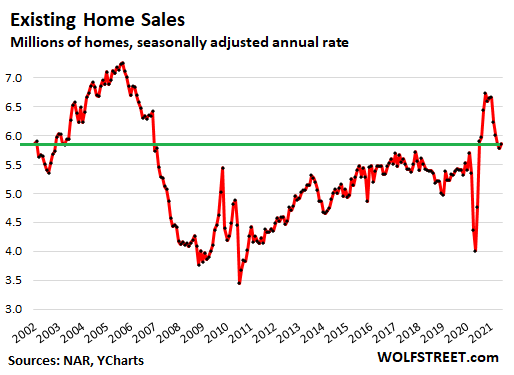
Sellers are now gradually coming out of the woodwork. There may have never been a more perfect time to sell a home: Prices have spiked amid clickbait stories in the media of crazy bidding wars where FOMO-driven buyers bid up no-matter-what, sight-unseen, inspections waived, and sellers can get away with anything. For buyers, this is a perfect time to make a terrible deal. But who cares. For sellers, it’s ideal. And sellers are starting to see it that way.
New listings rose by 11% in June, from May, when they normally, in the pre-pandemic years, declined from May, May being the seasonal peak of the year for new listings. But not this year: 446,600 new homes were listed for sale in June, up 11% from May, and the most since September 2019, according to the realtor.com residential listings database (the Junes are connected by a green line):
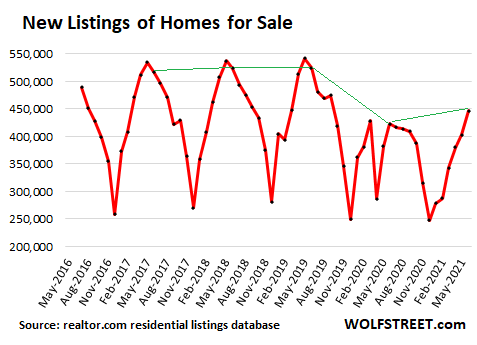
Total inventory of unsold homes on the market rose 3.3% in June from May to 1.25 million homes, the fourth month in a row of increases. Inventories are still very low, but are at the highest level since last November.
Supply of unsold homes on the market rose to 2.6 months, the fifth month in a row of increases, and the highest supply since last September (data via YCharts):
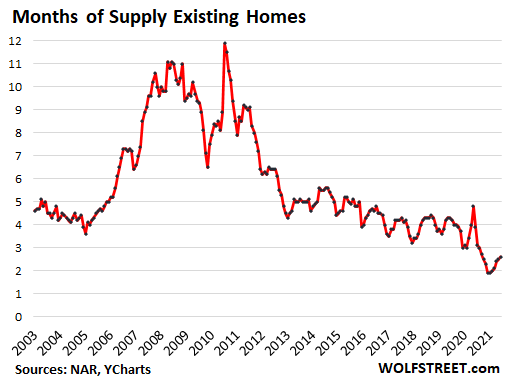
For people who bought a home, the meme during the pandemic has been to not put the now vacant prior home on the market, but instead ride up the steamy price spikes all the way before selling it. That math has worked out so far.
But surveys of homeowners, including a survey of homeowners by the NAR, show that are much larger than typical portion of homeowners plan to sell their home over the next 12 months, with over half of them planning to list their home this fall. And we’re now seeing the first glimpses of the reversal of the meme.
In Fannie Mae’s latest monthly National Housing Survey, the percentage of people who said that it was a “bad time to buy a home” spiked for the third month in a row to a blistering record 64%, with respondents citing home prices as the predominant reason. This survey was created during the housing bust, and the data only goes back to 2010.
And a record 77% of respondents said that it was a “good time to sell a home”:
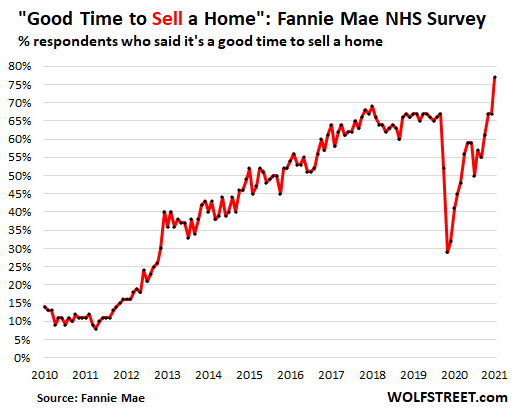
Investors and cash buyers were big, but mortgages dropped to 2019 levels. In June, 23% of the sales were all-cash, same as in May, and up from a 16% share in June 2020. This includes institutional investors that can borrow at the institutional level, instead of via mortgages for each home, and it includes individual investors and second home buyers that have the cash, or can borrow against their portfolio, and get a mortgage later.
With cash-buyers out there in large numbers, mortgage applications to purchase a home have more than unwound the pandemic spike. The Mortgage Bankers Association’s weekly index of purchase mortgages in recent weeks has been mostly below the same period in 2019 (data via Investing.com):
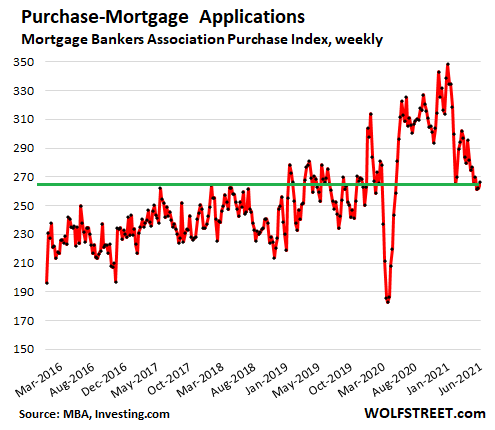
Crazy Spiking Prices continued. The median price for existing homes spiked by 23.4% in June, compared to June last year. The previously typical seasonal fluctuations have been completely abolished since March 2020, an indication of just how upended the housing market has become. The prior seasonal price peaks through 2019 occurred in June, and prices began to drop seasonally in July. A price drop in July this year would indicated a reversion to seasonality, which would be a first step back from the craziness (data via YCharts):
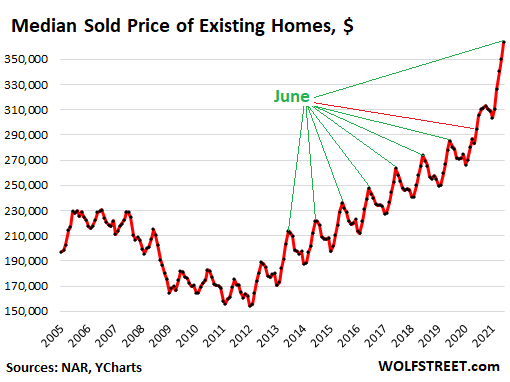
Enjoy reading WOLF STREET and want to support it? Using ad blockers – I totally get why – but want to support the site? You can donate. I appreciate it immensely. Click on the beer and iced-tea mug to find out how:
Would you like to be notified via email when WOLF STREET publishes a new article? Sign up here.

Watch as our sponsor, Classic Metal Roofing Systems, discusses the benefits of using products they manufacture.
Product information is available at Classic Metal Roofing Systems, manufacturer of beautiful metal roofs.
